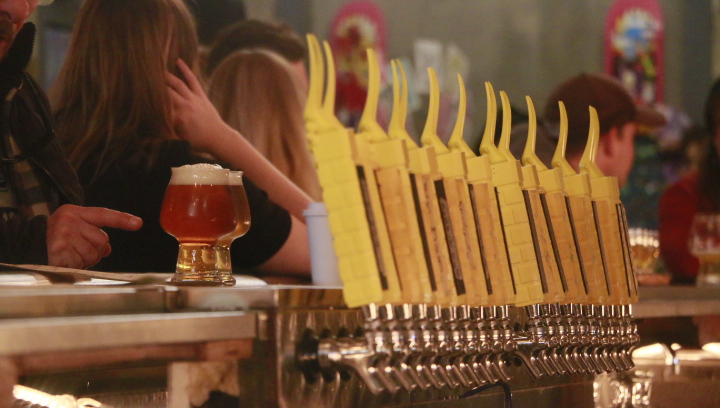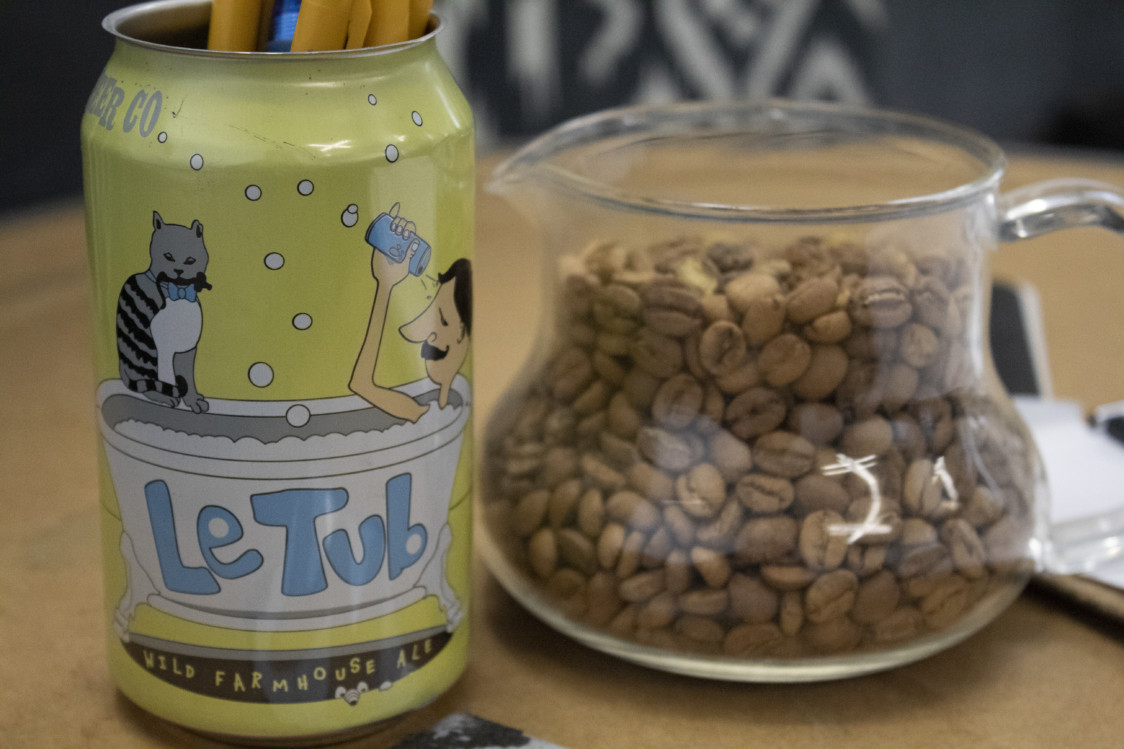The floors of The Plant are cleaned with beer. Okay, not beer, per se. More like leftover beer water — or at least the water Whiner Beer Co. has at the end of the beer-making process. It doesn’t smell. It doesn’t have any alcohol. It’s just water. And normally it’s just flushed down the drain.
But that’s not how The Plant—or Whiner Beer Co., for that matter—operates. The Plant, a former meat-packing plant turned Chicago’s largest sustainability experiment, is a closed energy system. Everything gets reused. And Whiner Beer Co. is the beating heart of The Plant. The heat it emits is used systematically to keep the building warm. Spent grain feeds the animals housed in The Plant, namely fish and chicken. Its leftover water cleans the floors. And as for the beer, well, that keeps the people happy.

But Brian Taylor and Ria Neery, co-owners of Whiner Beer Co., are excited about more than just their beer.
Both have long known that the brewing industry is highly resource-intensive. It takes seven barrels of water to make one barrel of beer. Over 10,000 pounds of spent grain accumulate in a month. Taylor and Neery wondered if there was a way to make those into positives. How could they use their byproducts in a way that benefits the environment along with their economic and social well-being as a brewery?
There are a number of answers.
No-Waste Connections Within The Plant
Whiner Beer Co. moved into The Plant in 2012 and quickly became a staple of the zero-waste community that its owner, John Edel, was cultivating — namely through the byproducts they create, which are highly utilized by the other tenants.
“We were pretty excited to move in there and then start that mission statement of being a zero-waste, fully sustainable brewery,” Taylor says .
The brewery doesn’t use any waste from the other tenats in The Plant, because of beer brewing’s specific needs, but most of their waste spreads out to the other businesses and even some of the research initiatives, spearheaded by the nonprofit housed in the building:
- The spent carbon dioxide goes to sustain The Plant’s algae lab. Since beer is carbonated, it takes a lot of carbon dioxide. This carbon dioxide is eaten by the algae and turned into oxygen.
- Whiner makes the spent grain into soil by mixing it with wood chips and horse manure. It’s composted into black soil and used in gardens located in The Plant’s backyard area. If The Plant doesn’t need it, it’s sold to other stores such as Home Depot.
- The spent grain is also fed to fish or given to Pleasant House Bakery, another business within The Plant, where they make a couple of different breads with the grain.
- Any drainage from the brewery goes back into a single tank where the pH is changed back to seven, making the water neutral again. It’s then used for cleaning, such as mopping floors.
- The sugar water that would usually go down the drain is used for protein chips at BTRFY, one of the small business productions in The Plant.

Different types of beers can also be worse for the environment. For example, lagers take more time to ferment, meaning they’re breathing more carbon dioxide into the air. Ales take about half the time to ferment, meaning less emissions. Because of this, Whiner focuses on making more ales than lagers.
No-Waste Connections in Beer Brewing
Ian Hughes, the sustainability ambassador for the Brewers Association, travels to breweries around the U.S. and shares information on sustainability and tactics for getting in on the zero-waste effort.
“We’re trying to destigmatize … People hear the word sustainability and they freak out,” Hughes says. “It’s about taking baby steps, understanding what you can do.”
Hughes shares how he has seen both some of the largest breweries, and some of the smallest startups tackle sustainability in unique ways:
- The spent grain can go into making other products, such as dog biscuits and pizza crust, or sending it to farms for animal feed.
- Using cans instead of bottles can be more efficient. Since cans are lighter, more can fit on a truck, lessening the amount of transportation needed. Less transportation can cut out some carbon dioxide emissions.
- Using pint glasses instead of paper or plastic cups at a brewery can eliminate unnecessary waste.
- Composting when possible, mostly small scale materials such as food. If breweries use speciality items in their beers, such as cocoa beans or fruit, they should compost them as opposed to tossing leftovers in the dumpster.
- Supporting local breweries, and other local businesses can cut down on transportation costs and carbon dioxide emissions associated with shipping goods.
High Sustainability Content
Whiner isn’t the only brewery making sustainability a focus. Anheuser-Busch is also thinking more about it, using its water and electricity more responsibly. One hundred percent of its electricity comes from renewable sources and it’s working on reducing carbon dioxide emissions across the board by 25 percent. The company is developing new barley varieties that can use up to 40 percent less water, and all of its packaging is made from recycled material.
Other breweries are jumping on the idea of becoming self-sustained as well:
- SingleSpeed Brewing Co.: Similar to The Plant, this brewery, located in Waterloo, Iowa, inhabited and then remodeled an old Wonder Bread facility. They monitor water consumption through the use of flowmeters throughout their facility, and the roof is solar-paneled, reducing overall energy consumption by 25 percent. It also partners with other sustainability-based companies in the area, such as the Iowa Bike Coalition and the Prairie Rapids project.
- Sierra Nevada: The company has found a way to capture carbon dioxide that would otherwise go into the atmosphere. Its carbon dioxide recovery system takes in the carbon dioxide released during the fermentation process, and it’s kept for later use in the brewery, which means the company doesn’t have to buy carbon dioxide from other companies. In response to the fires ravaging California, Sierra Nevada is brewing a new beer, Resilience Butte County Proud IPA, from which 100 percent of the proceeds will go to Sierra Nevada Camp Fire Relief Fund.
- New Belgium: New Belgium uses only four barrels of water for every barrel of beer, as opposed to the usual seven.The amount of water that goes into crafting beer depends on what type — hoppy beers use more water than others. It also diverts 99.8 percent of its waste from landfills.
- Brewery Vivant: Vivant is a certified B Corporation, meaning it’s a for-profit company that’s been certified by the nonprofit B Lab, which holds companies to a higher standard of social and environmental performance, accountability, and transparency. It was awarded the very first Leadership in Energy and Environmental Design certification for a brewery in 2012. It’s also a zero-waste facility, and 75 percent of their expenses, such as supplies, come from within Michigan.
The Power of Beer
When sustainability comes into conversation, customers’ eyes tend to glaze over, despite its importance, says Hughes. Breweries can have an immense influence on their environment, especially because of their constant use and release of carbon dioxide when making beer.
Their effect on the environment is important for brewers to understand, but also for their beer-loving consumers. Hughes says it makes a difference when consumers buy from sustainable companies.
“I always say beer is a really powerful megaphone,” Hughes says. “What’s fascinating is you put a beer in front of someone and all of a sudden you’ve got their captive attention for at least 16 ounces … and they listen to just about everything you have to say.”

